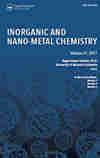Synthesis, Structures, and Properties of NiII, CoII, CuII, MnII, and ZnII Coordination Polymers Based on 5-Aminoisophthalate and 4-Amino-3,5-bis(3-pyridyl)-1,2,4-triazole
Synthesis and Reactivity in Inorganic, Metal-Organic, and Nano-Metal Chemistry
Pub Date : 2016-04-02
DOI:10.1080/15533174.2014.988804
引用次数: 0
Abstract
Self-assembly of 5-amino-isophthalic acid (H2aip) and 4-amino-3,5-bis(3-pyridyl)-1,2,4-triazole (3-bpt) with Ni(NO3)2, Co(ClO4)2, Cu(NO3)2, Mn(OAc)2, and Zn(NO3)2, respectively, under similar reaction condition affords five new coordination polymers {[M(3-bpt)(aip)(H2O)2]·(H2O)2}n (M = Ni for 1, Co for 2, Cu for 3, Mn for 4, and Zn for 5). Single-crystal X-ray diffraction indicates that coordination polymers 1–5 show isostructural 1D double-chain structures, and the metal centers exhibit the same octahedral coordination environment. The carboxyl groups of ligand aip2− adopt the same bis-monodentate bridging mode in all structures. These low-dimensional coordination motifs in 1–5 are further extended to the resultant three-dimensional (3D) supramolecular networks via H-bonding interactions. Furthermore, FT-IR spectroscopy, elemental analyses and thermogravimetric analysis (TGA) for 1–5 have also been studied in this article.基于5-氨基间苯二甲酸酯和4-氨基-3,5-双(3-吡啶基)-1,2,4-三唑的NiII、CoII、CuII、MnII和ZnII配位聚合物的合成、结构和性能
在相似的反应条件下,5-氨基间苯二甲酸(H2aip)和4-氨基-3,5-双(3-吡啶基)-1,2,4-三唑(3-bpt)分别与Ni(NO3)2、Co(ClO4)2、Cu(NO3)2、Mn(OAc)2和Zn(NO3)2自组装得到5种新的配位聚合物{[M(3-bpt)(aip)(H2O)2]·(H2O)2}n (M = Ni为1,Co为2,Cu为3,Mn为4,Zn为5)。金属中心表现出相同的八面体配位环境。配体aip2−的羧基在所有结构中均采用相同的双单齿桥接模式。1-5中的这些低维配位基序通过氢键相互作用进一步扩展到三维(3D)超分子网络。此外,本文还对1-5的FT-IR光谱、元素分析和热重分析(TGA)进行了研究。
本文章由计算机程序翻译,如有差异,请以英文原文为准。
求助全文
约1分钟内获得全文
求助全文
来源期刊
自引率
0.00%
发文量
0
审稿时长
5 months

 求助内容:
求助内容: 应助结果提醒方式:
应助结果提醒方式:


